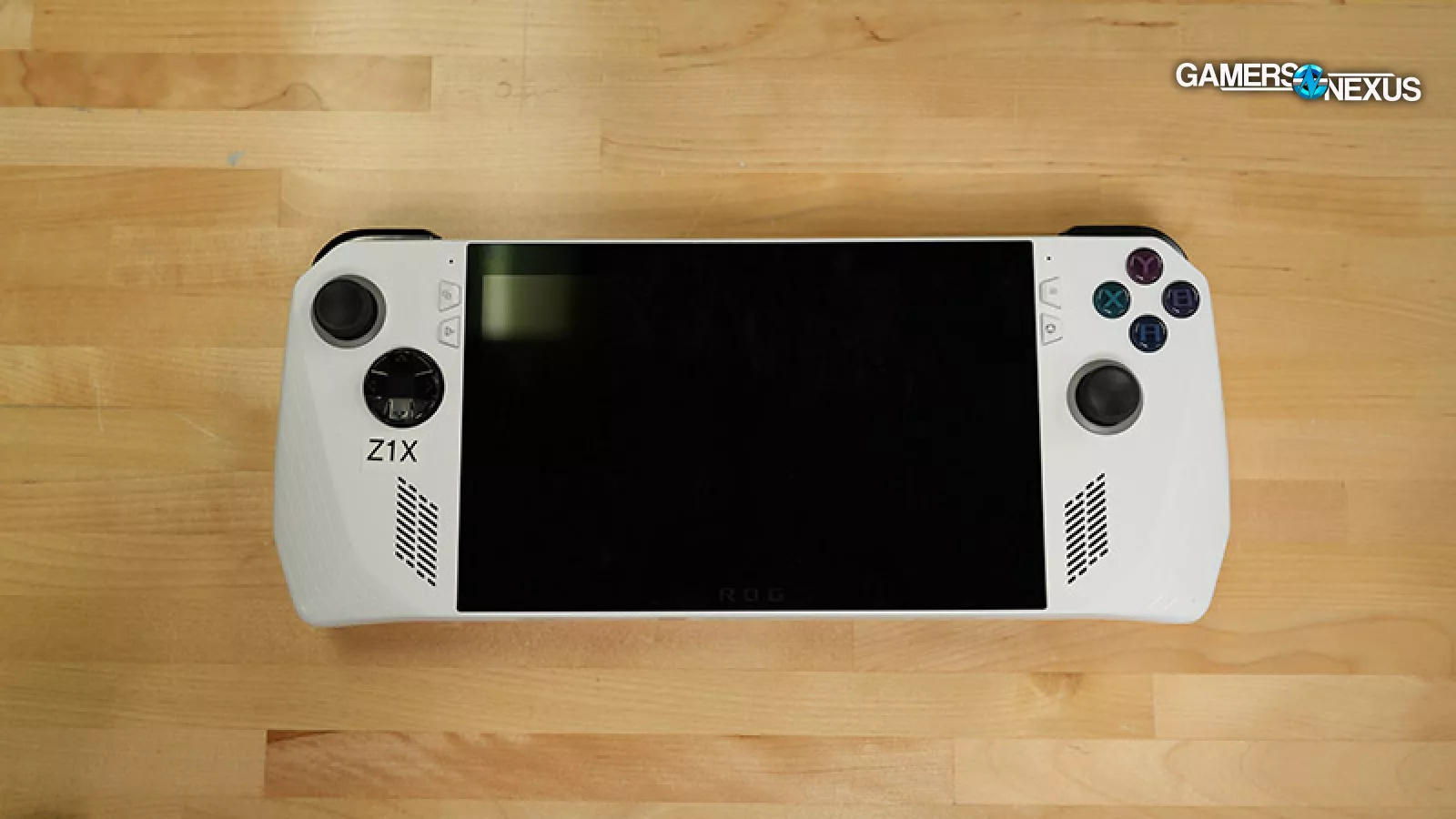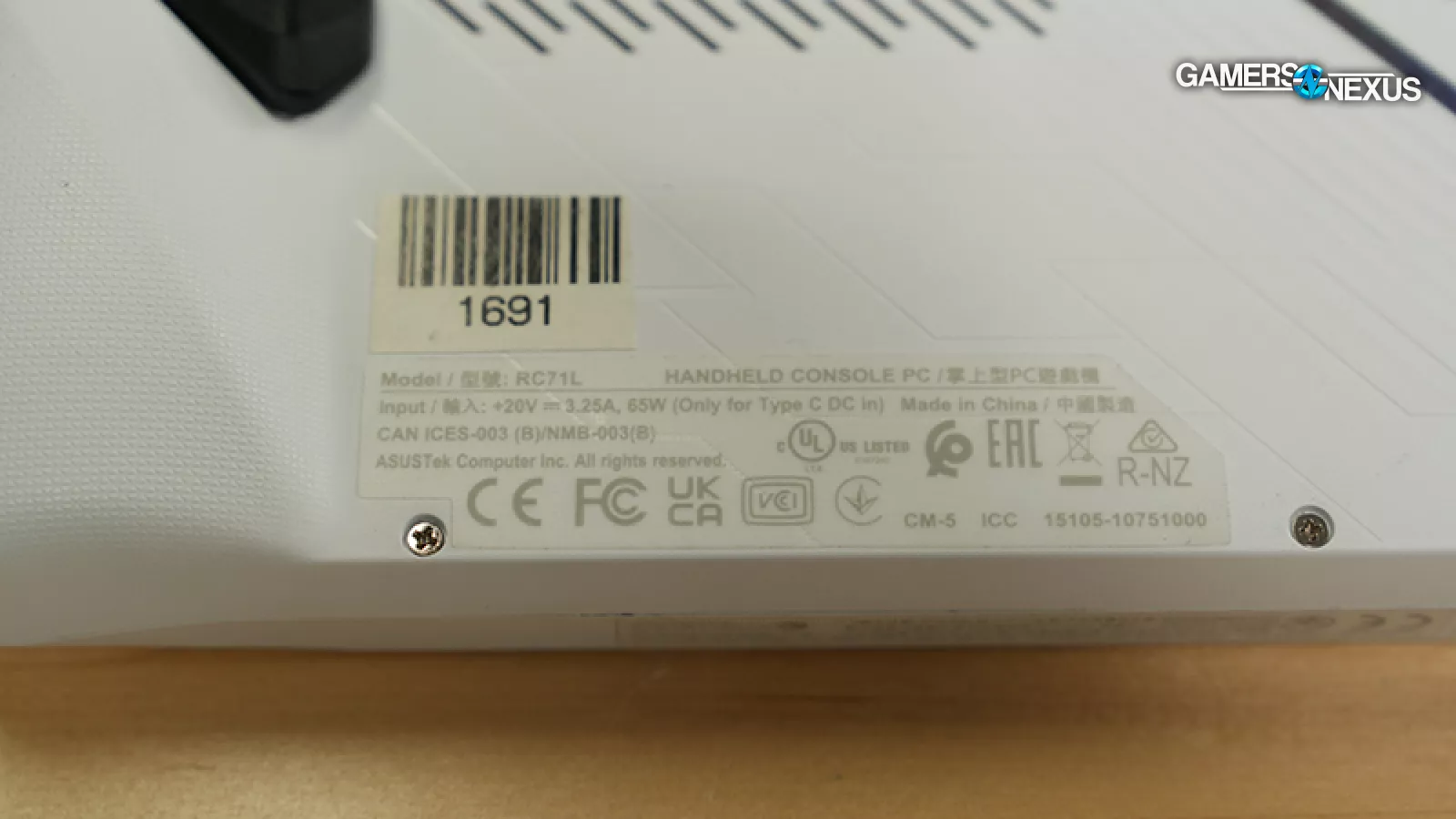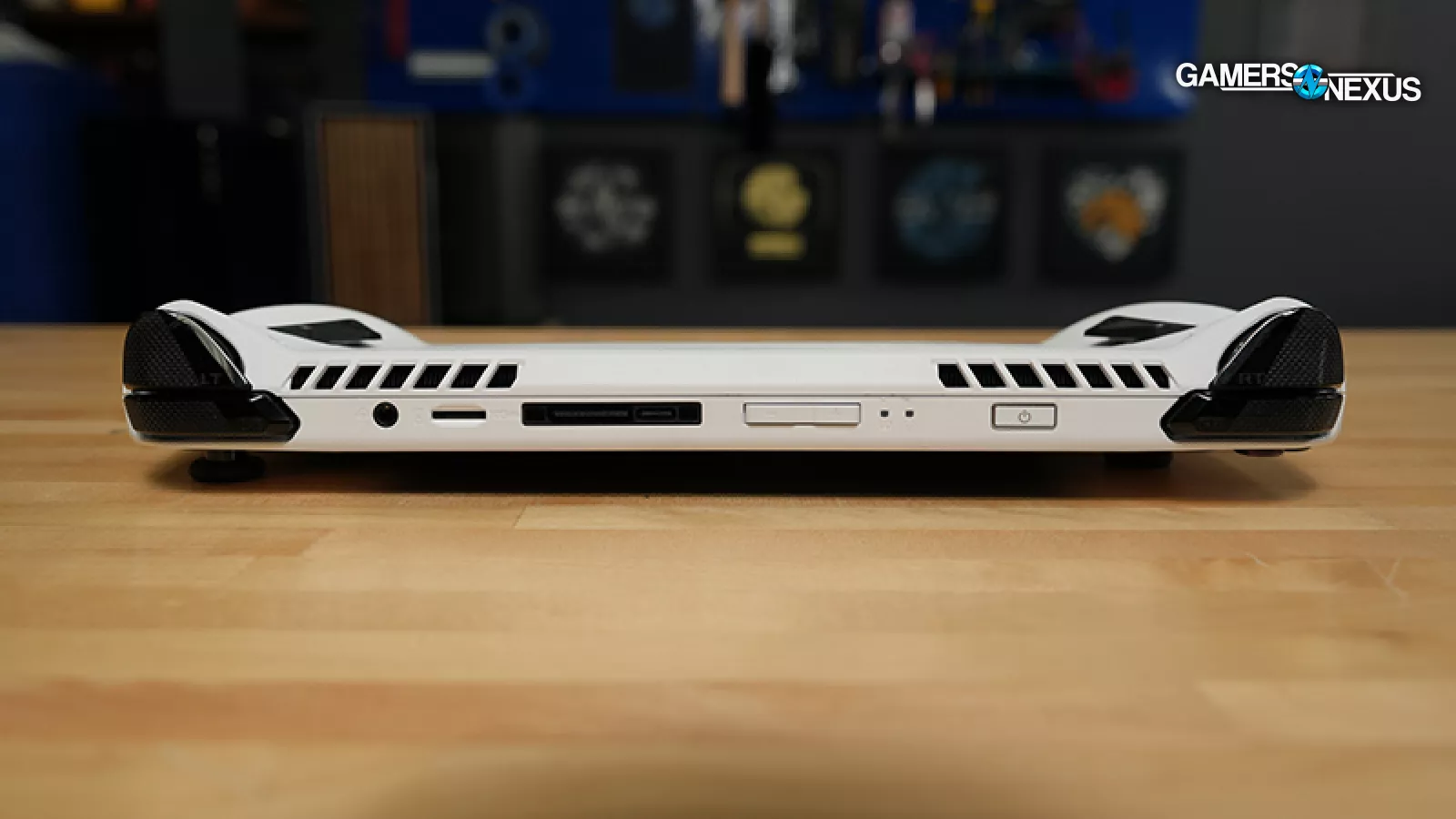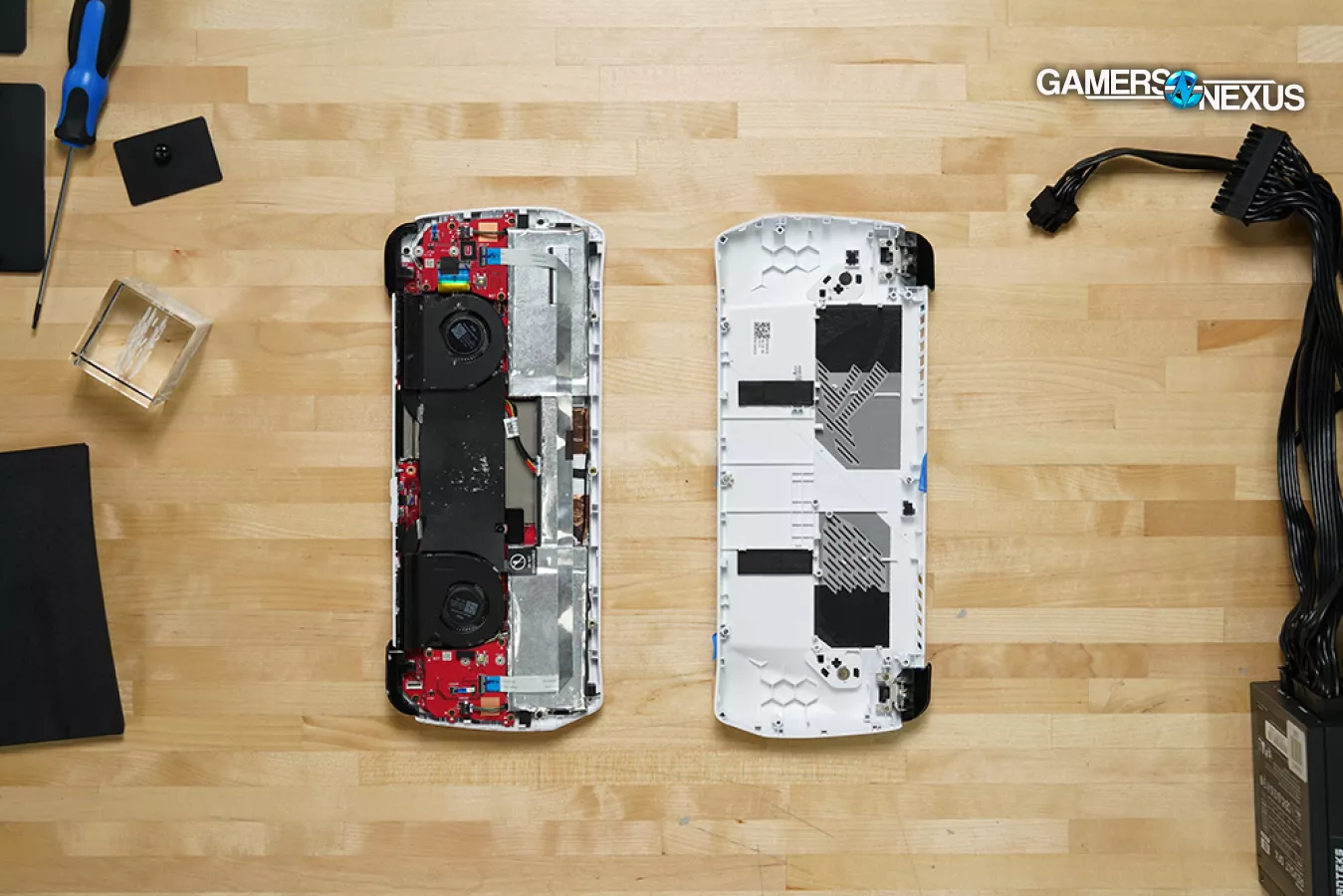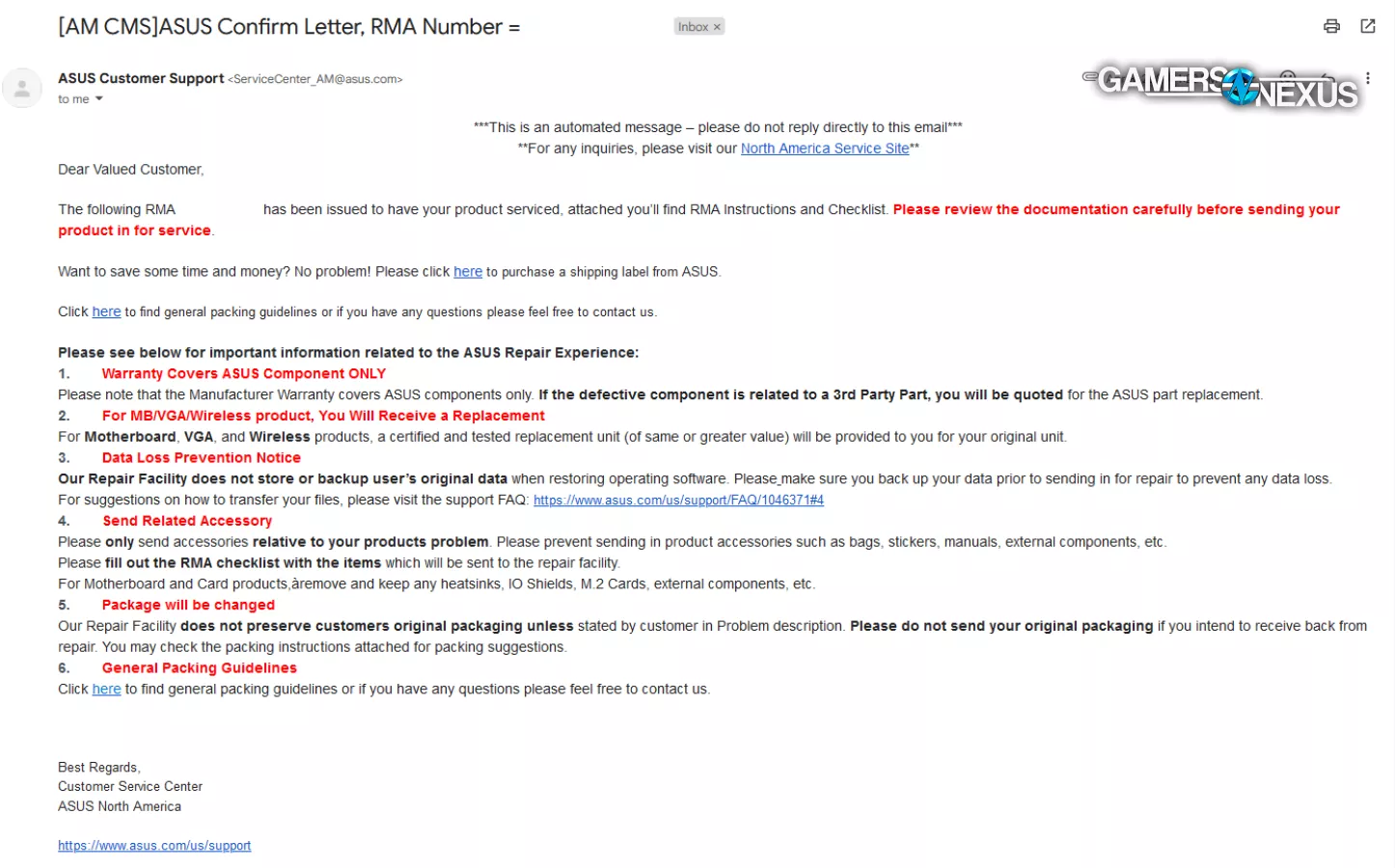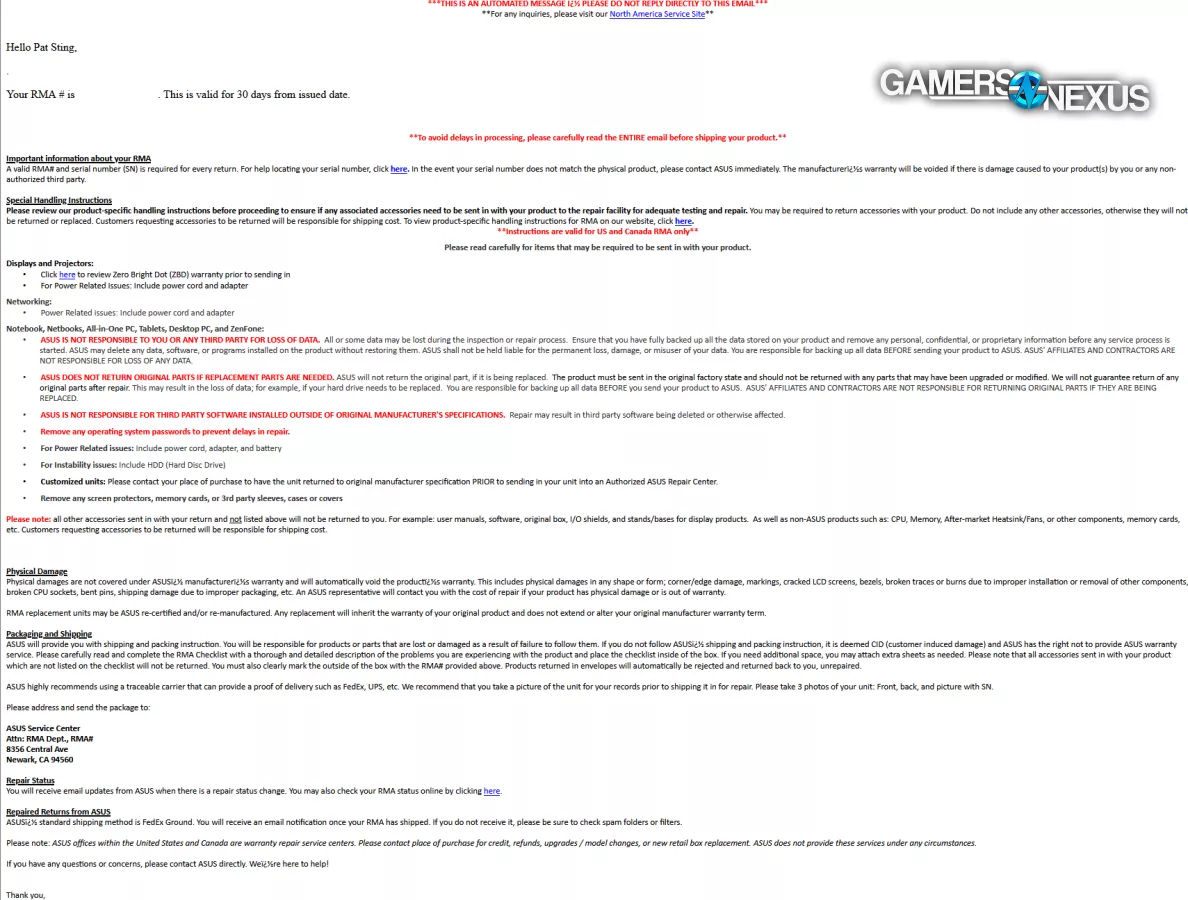
A permanent reference guide for common warranty refusal tactics and their responses
The Highlights
- Includes references to US Law, but has guidance applicable everywhere
- Warranties can be rejected for invalid or even illegal reasons
- This content informs you of your rights and makes preventative recommendations
Table of Contents
- AutoTOC
Intro
This guide is designed to maximize your protection as a consumer in the event of a warranty claim. This does not constitute legal advice; however, it does include legal references that will help reinforce your claims if they are rejected.
Our specialization is in computer and gaming hardware, so that will be our focus; however, aspects of this could be applied to nearly any warranty claim.
We are writing this following our ASUS RMA Investigation Pt 1 (“ASUS Scammed Us”) and our ASUS Response Pt 2 (“ASUS Called Us Confused”). The experience was a great learning exercise that we can apply to any manufacturer which either unlawfully rejects a warranty claim or which rejects a claim without proper foundation. We have been communicating with lawyers and experts in Right to Repair/the Magnuson-Moss Warranty Act to better understand the advocacy around these deeply important consumer rights issues and how to self-advocate in a scenario where you feel a manufacturer is unfair or unlawful in its conduct.
Credits
Writing
Steve Burke
Enough is Enough
A personal note: We have covered many warranty issues over the years. At this stage, GN has grown enough, and I have grown dissatisfied enough, that we are starting the process of taking our findings to lawmakers. We have begun the process of connecting with Congressional and Senatorial representatives, are contacting the Federal Trade Commission, and have begun interviews with experts and advocates for consumers on these matters. This is not just an ASUS issue. We hope to educate ourselves enough on the legal specifics of both Right to Repair and acts like Magnuson-Moss so that we can take up the fight for consumers to politicians to push for action. Although some smaller companies may act in the interest of consumers, large corporations are often calculating when it comes to which consumer rights they respect.
Laws can change the outcome of this calculation.
Our focus is on the US because that’s what we know and that’s where we live. But many of these self-advocacy concepts can apply globally.
Warranty claims are frequently met with what we’d consider to be BS responses, such as claims of “customer-induced damaged” (CID) that are unfounded or irrelevant. Our video component accompanying this article will address many of those situations with expert Nathan Proctor of the Public Interest Research Group (PIRG), which is an advocate of public interest matters like Right to Repair. You can find that discussion in the video component only.
Warranty Fraud: How to File a Report
FTC Warranty & Consumer Reports
Let’s start with the easiest thing: If you’ve already been screwed in a warranty process and you believe it to be unfair and potentially illegal, it is easy to file an FTC Report. THESE ARE IMPORTANT. The more consumers are aware of these, the more likely it is that the FTC gets involved to straighten-out companies internally and compel change through fines and action.
You can file a report here: https://reportfraud.ftc.gov/form/main?TC=RightToRepair
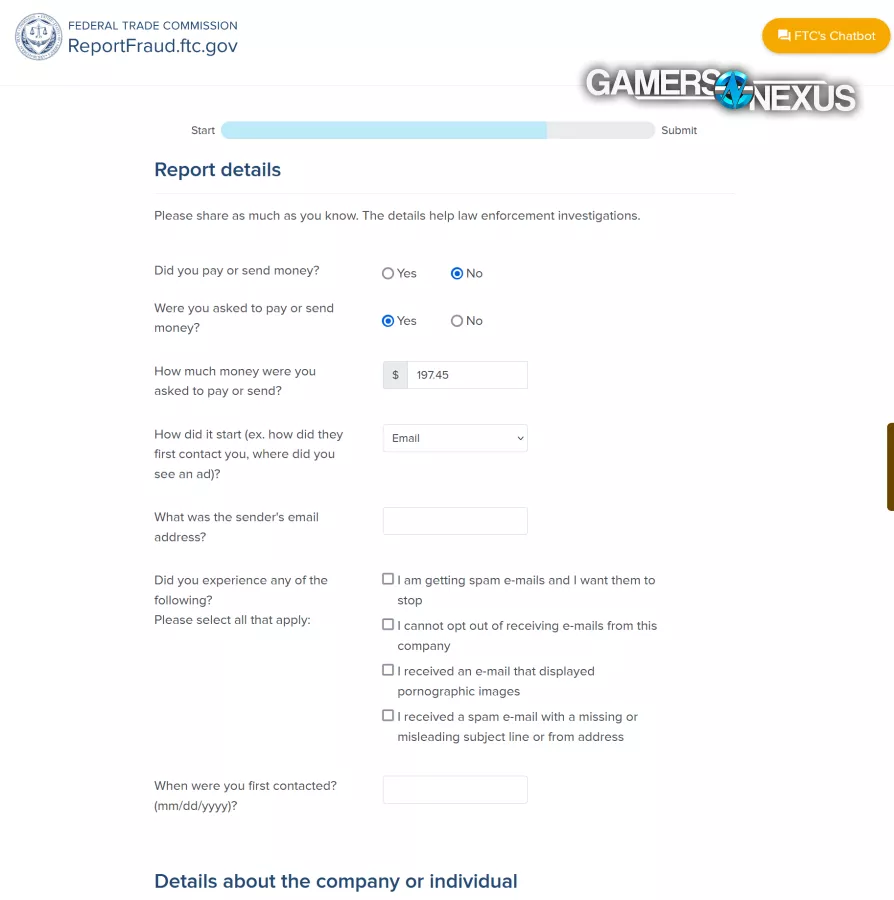
Fill in the details pertaining to the charges (if you paid anything for the claim or were requested to pay, but didn't). Choose the form of contact you used to engage with the company.
Enter their email address or support address.
Most likely, you will leave all the checkboxes blank. The issue is a Warranty issue, not one of these.
Enter the date of correspondence.
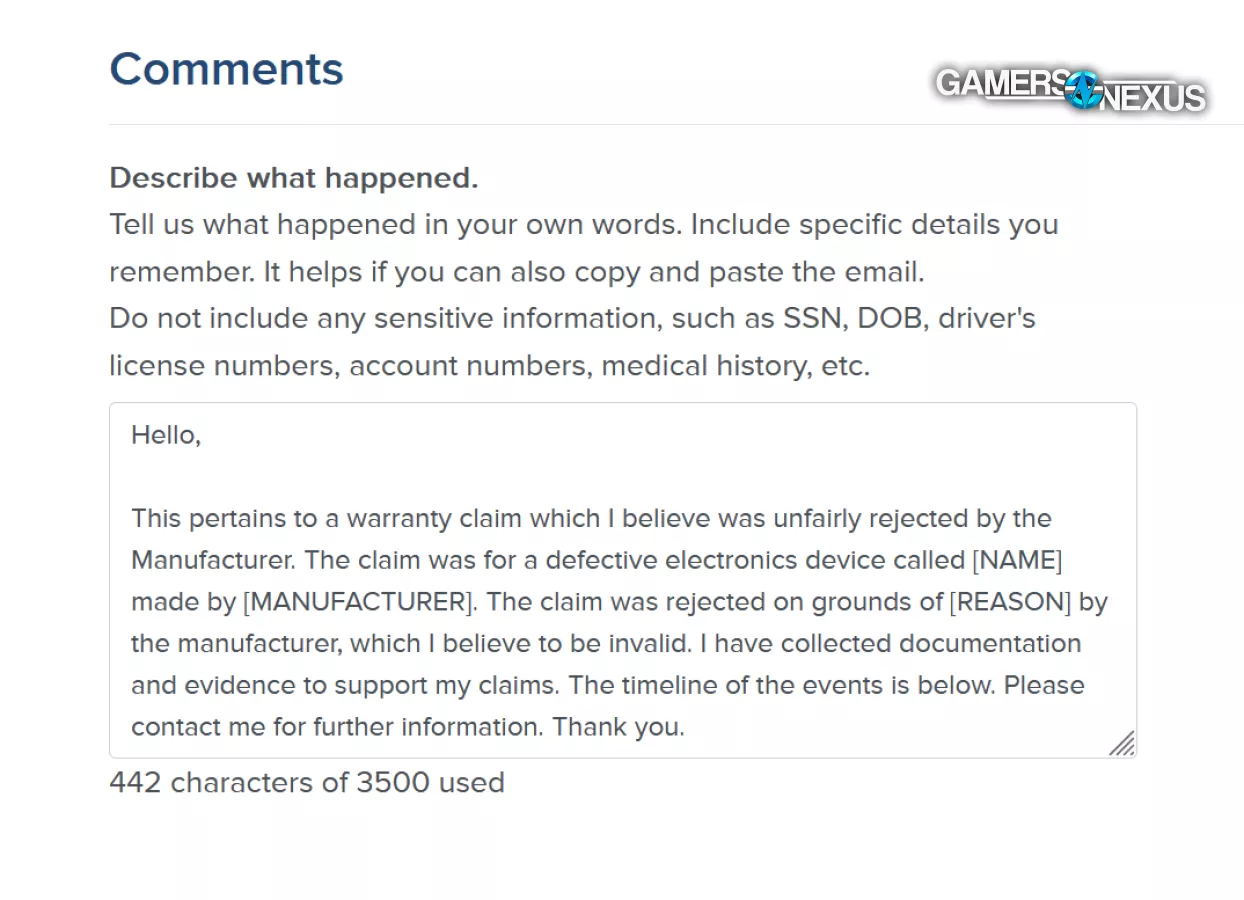
In the Comments box, provide a brief description of the events and a timeline. We would recommend starting with:
“This pertains to a warranty claim which I believe was unfairly rejected by the Manufacturer. The claim was for a defective electronics device called [NAME] made by [MANUFACTURER]. The claim was rejected on grounds of [REASON] by the manufacturer, which I believe to be invalid. I have collected documentation and evidence to support my claims. The timeline of the events is below. Please contact me for further information. Thank you.”
The two fields pertaining being requested to send money are important. Fill those in truthfully.
These reports matter. The more there are, the more likely it is the FTC gets involved to slap corporations.
Finalize your report and submit it.
Warranty Claim Self-Advocacy Kit
This kit contains:
- Examples on how to open a ticket and minimize time spent in “RMA hell”
- Examples of documentation to best protect yourself from false claims
- Example responses, including pushback responses
- Examples of how to read warranty language
Simple Steps: Successfully Claiming a Warranty
Live by the mantra “document everything” for your claims. We’ll start with the steps broadly, then drill-down. This is assuming you have a valid claim. Remember that not all damage is covered by warranties.
- Before filing your claim, check the date of purchase
- Even in the US, if you purchased from a retailer, you may be covered by the retailer. Most retailers have a 30-60 day window where you can return an item directly. We always recommend this path if a new device is defective. Check the retailer’s return policy. If it is not merchantable (it ships defective), you have a LEGAL RIGHT to return the device. This is always easier.
- Before filing your claim, check the duration of the warranty period and get a basic understanding of what might be covered
- If you have it, find your original purchase receipt and have it saved in case the representative requires proof of purchase. This is somewhat common.
- Determine in as few words as possible how to explain the details of the claim. We have examples below
- File your claim via email if possible or chat (and save the logs) if not. If you use phone support, we recommend writing down all agreements reached on the call and then reading them back to the representative at the end of the call. Ask the representative to confirm that your understanding of the next steps is correct. Ask the representative for their email address, then email them the call notes. Start the email with,
“Hello [name],
As you confirmed on the call, my next steps are as follows:
[paste notes]
Thank you,”
This will give you something in writing. If they do not reply to dispute your claim that they confirmed this, you likely have created standing for a dispute later. If they dispute it, get on the same page and proceed. - Document the device in detail before returning it. Take photos of all angles and record serial numbers. Examples below. Fragile items like motherboard sockets should be documented specifically
- Before shipping a device, ask for packing instructions or look them up from the manufacturer. Following packing to the spec removes their ability to claim you were at fault for improper shipping.
- Document the packed device with photos. Follow the shipping spec provided so that it becomes the manufacturer's liability
- Ship the device. Follow tracking and save a screenshot of the tracking information once it is marked as delivered so that you have proof of delivery. These tracking pages are often deleted within 14-60 days.
- Check regularly for responses so that you do not miss a short window for response
- Following the examples below, do not accept any unnecessary repairs and advocate for your rights
- Escalation is an option. Described below.
- When you receive the new device back, IMMEDIATELY photograph the package, including the exterior and interior packing, before disturbing it. Open the package and inspect the device. Look for new damage or a possible replacement.
- Document (photograph) the device in its new state
- Thoroughly test the device for its old issue and for base functionality to ensure no new issues. A refurbished part may have new problems (for example, we received a refurb laptop once to fix a hinge problem and the new device had a broken Bluetooth module that we didn't discover until it was too late to return again).
- That should be it
Returning to Stores
We always recommend returning a device to a retailer if it has broken (or arrived broken) within the return policy window. Steps:
- Navigate to your retailer’s website or email them and check the time window for returns. Most are 30-60 days. Some are longer.
- Advocate for a pre-paid shipping label if the item sold to you was already broken or defective.
- Take photographs of the device (if it was opened) and its box (if it was unopened, showing the seal)
- Ask the retailer for return packaging instructions and document them. This protects you from a counter claim of improper shipping protection causing damage
- Take photographs of the packaging and the package, then ship it
- Save the tracking report once it marks as delivered
- Know your rights (below)
Legal Right to a Functioning Product
You have a legal right to a functioning product on purchase. If the product develops a defect over time, that may fall under the manufacturer’s warranty rather than the store’s legal requirements to sell you a functioning product.
Recommended reading: The Business Guidance from the Federal Trade Commission on “Implied Warranties.” It is written in clear language, not legalese. The below is written by the FTC to business owners (emphasis ours):
“Implied warranties are unspoken, unwritten promises, created by state law, that go from you, as a seller or merchant, to your customers. Implied warranties are based upon the common law principle of ‘fair value for money spent,’ There are two types of implied warranties that occur in consumer product transactions. They are the implied warranty of merchantability and the implied warranty of fitness for a particular purpose.
The implied warranty of merchantability is a merchant's basic promise that the goods sold will do what they are supposed to do and that there is nothing significantly wrong with them. In other words, it is an implied promise that the goods are fit to be sold. The law says that merchants make this promise automatically every time they sell a product they are in business to sell. For example, if you, as an appliance retailer, sell an oven, you are promising that the oven is in proper condition for sale because it will do what ovens are supposed to do—bake food at controlled temperatures selected by the buyer. If the oven does not heat, or if it heats without proper temperature control, then the oven is not fit for sale as an oven, and your implied warranty of merchantability would be breached. In such a case, the law requires you to provide a remedy so that the buyer gets a working oven.” - FTC.gov
This material is useful if you need to defend a case for a retail return/exchange for an item sold broken.
Retailers have valid reasons to reject returns (such as the customer destroying the product) or to force the customer to eat costs (such as return shipping). Examples might include purchasing a product, realizing you bought the wrong thing, and sending it back. That would be the customer’s fault. In instances of a defective product being sold, however, US retailers are compelled under US law to accept the return and either exchange the item or refund you. This will be the path of least resistance if within the return window.
Fight for a pre-paid shipping label if the product is defective through no fault of your own. If they sold you a broken item, you should not have to pay any shipping costs.
Filing a Manufacturer Warranty Claim
When filing a warranty claim, we recommend contacting the company exclusively via email if possible. Live chat windows are also OK; however, make sure you save a record of the conversation. Not all chat windows will offer a log download option at the end, so we recommend taking regular screenshots of the entire chat. Email is preferable as it is easier to store and timeline.
Approach
Approach the support representative professionally and calmly. Although frustration has its place in the RMA process, it’s better to save that as an escalation step.
State to the representative in clear, plain language what has failed. Do not elaborate until they ask for elaboration. Typically, representatives will ignore additional detail until they ask you some questions, so you will grow frustrated repeating yourself -- best to just keep it simple at first.
Let’s take an example. If you have a failed microSD card slot reader on a device, you might write the below:
“Hello,
My ASUS ROG Ally cannot read microSD cards. My serial number is ABC123. I bought the device 6 months ago. I would like to start a repair process under the warranty. My order number is 0123456 and I purchased it directly from ASUS.
Thank you.”
That’s it. This is clear, concise, states the timelines they need, but doesn’t overburden them with information that will likely be ignored until they ask follow-up questions. There is no need to explain all of the troubleshooting steps. They will prompt you with those, and as they arise, you can inform them professionally, clearly, and plainly, but politely, that you have taken (or are taking) each step as it arises. Dragging a representative off-script will only cause more frustration. Remember, our end goal is to get the device fixed.
Let’s turn this into a series of templates.
(Template) Initial Correspondence
We spoke with a few (good-intentioned) industry warranty centers and asked them what email would most effectively produce a quick path to answers. The below is a combination of this guidance and our own experience.
For your first contact, try an adapted variation of the below:
Hello,
My [DEVICE NAME] is exhibiting a problem with the [COMPONENT]. The serial number is [S/N NUMBER] and the model or part number is [PART NUMBER]. I bought this device on [DATE]. I would like to start a repair process under the warranty. My original order number is [ORDER NUMBER] from [MANUFACTURER OR RETAILER]. Please advise.
Thank you,
This is polite, clear, and professional. Providing the dates and order numbers early will accelerate your process, especially if it is email. We find email to be less frustrating than chat, as there is often less repetition.
When the representative responds, they will likely ask you to perform some troubleshooting tasks. Rather than listing everything you have done, instead allow them to tell you what to do. If you’ve already completed that step, tell them and note whether it worked or not. This will save frustration by not providing unnecessary or unhelpful information. Remember that most representatives follow a script.
Ask the representative to confirm that the defect is covered under the warranty. Get this in writing and save it.
Once this phase is done, they will likely begin the process of starting a repair.
(Template) If the initial response is positive:
You will begin the process of the repair. Send this to the support representative after reading and responding to any of their questions:
Hello,
I will begin packing the device to return it. Can you please help with a few questions?
1: Should I include any of the device accessories with the device? Will I get them back if they are included?
2: If I still have it, should I pack the device in its original packaging? Will I get it back if I do?
3: Can you please provide detailed packaging instructions to protect the product in shipping?
4: Can you please provide a shipping label for the defect?
[if the device has storage] 5: For security purposes, I am going to remove my SSD or storage device to protect my data. Please note this in my ticket.
Thank you,
This is designed to create some legal standing and ammunition for a pushback later.
GN strongly recommends removing your storage devices. In the US, a manufacturer should not use this against you, and if they do and you are in the US, you may cite the Magnuson-Moss Warranty Act and state to the agent that you will file an FTC report if a warranty claim is rejected for an unrelated modification. If your device has internal (soldered) storage that cannot be removed, we recommend BACKING UP THE DEVICE. If the manufacturer replaces your device, YOU WILL LIKELY NOT GET YOUR DATA BACK. We would also recommend removing any sensitive information from the device prior to dispatch.
Save the answer to the above questions. Follow the packing instructions precisely and document this.
(Template) If the initial response is negative:
“Respectfully, it is my understanding that the Warranty included with the product covers defects of material quality, workmanship, and design for a period of [YEARS WARRANTED]. I would like to send my device in for inspection and would appreciate you helping me to do that. Are you saying that this product is not covered by the Warranty? If so, please state your reasons why.”
If the response is still negative and if you disagree:
“Between the written Warranty of the product and the Warranty provisions by the FTC, I believe that my claim should be covered. Can you please escalate me to a supervisor? Thank you.”
At this point, your goal is to get a ticket generated and get the device in front of them. Because the device is not even there yet, this should be achievable.
Progress will be easier once it is there as the path of least resistance then would be to just fix it or send you a replacement.
Possible Rejection Reasons & Responses
Once the device is received, remember it is possible that you have in fact caused some damage to the device. In such an instance, you should have ample documentation from prior to sending the device in. Always remember to check your own documentation and photos before pushing back.
Having this documentation is for two reasons:
- To check that your own memory of events is correct and prevent from being gaslit by a manufacturer
- To check that, perhaps, you did cause some damage. In this event, check next that the damage is relevant to the claim. If it is not, it is not a valid reason to reject the claim
The manufacturer’s most likely reasons for rejection will be:
- Liquid damage
- Customer-induced damage
- Tamper seal or “Warranty Void” sticker punctured, or a makeshift interpretation of this
- Unwarranted failure
- Unwarranted use of product
- Wear and tear
Let’s go through this:
Liquid Damage: This is a very common counterclaim and is almost used as a blanket statement. If you know the device has never been exposed to liquid, the only remaining explanation for a liquid sensor tripping would be from a humidity sensor. Assert with the manufacturer that the device has never been exposed to liquid and demand evidence of their claim. If they indicate a humidity sensor, state that this does not constitute liquid damage and that the device has never been exposed to liquid (if this is the truth).
Customer-Induced Damage: Ask for photos of the claimed “CID.” Compare that photo with your own documentation. If indeed the damage existed and was caused by you, next determine if it is relevant to the repair. If it is not relevant to the repair, state that you would like to ignore the “damage” and proceed with the repair of the [failed component]. If there is pushback, we’d recommend watching our video (embedded above) with Nathan Proctor to learn about your consumer rights in this regard.
Tamper Seal or Warranty Void Sticker: Warranty Void stickers are not enforceable. The FTC has stated, and now has cases reinforcing (see: Harley-Davidson, Weber Grills), that consumers and third-party service providers have a right to repair a device without the manufacturer’s involvement. Puncturing a sticker is not sufficient to reject a claim.
Unwarranted Failure: This is trickier. You would have to ask more questions about why the failure is not covered. If, ultimately, it has nothing to do with your use and is not a consumable item, then push back.
Unwarranted Use of the Product: First, we’d recommend against telling the manufacturer how you use(d) the product. There’s no real reason to give them that information. If the manufacturer claims your use is not covered, ask them to show you where in the Warranty it is stated that your use is explicitly not covered. Maybe that’s true -- but ask for proof.
Wear & Tear: This can be reasonable. As an example, a T-shirt that develops a hole over a period of years or a tire that has its tread worn. In electronics, this might be reasonable battery wear from excessive use: For instance, a 3-year-old phone would reasonably be expected to have severely reduced daily battery life by nature of how a battery works; however, a 3-month-old phone would be reasonably expected to bear similar life (capacity) to its original state. There is nuance in a wear & tear rejection. If you believe your claim to be reasonable, calmly explain why and ask for an explanation.
Ask for photographs of any claims from the warranty center pertaining to damage and check them against your own.
Examples of Documentation
When documenting your device prior to sending it in, we would recommend taking photos of:
- All sides of the device (in as high a resolution as you have available)
- Serial number stickers
- A brief video (cell phone is fine) of the defect itself. This will give you evidence of your original claim
- If the device is being opened anyway, photos of the internals. If you have no need to open the device, we would recommend against doing so if it’d only be for this step
- If the claim is something you can log in software, such as overheating, save a log file of the issue. You can use HWINFO and GPU-Z for most PC or handheld components. Worst case, take a photo of an overlay illustrating the issue
- Take photos of the packed device and the packed box itself
Example Device Documentation
For motherboards, it's very important that you also photograph the socket as closely as you can.
You should also document chat logs:
The point of all of this documentation is to only use it in the event you need to disprove a statement by the manufacturer. The goal is never to escalate to an actual court. That’s an option (and you can get Attorneys Fees in some situations under Magnuson-Moss), but no one realistically wants to do that. The best use case is to use this material to appeal to reason of a supervisor -- even if that means a reminder that you are protected under Federal law for a valid claim with a flourish of evidence.
Understanding Warranty Language
For this, we're including two videos featuring Attorney Vincent Agosta where we had discussions pertaining to ASUS' warranty processes. Although we spoke of ASUS, these apply broadly and can also help inform as to how to interpret certain language:
Contacting the Media
Finally, a last path of escalation is contacting the media. There are many outlets that may be happy to help you. We can only speak for ours, but normally the biggest limiter is just the volume of viewer emails. We can't read them all.
But it's worth contacting various members of the media for help if you do have a problem. Because responses aren't guaranteed, we'd recommend keeping them short and to the point (mostly so you don't sink a ton of time into something that may not be read).
When we do happen to land on one, we do our best to expedite our viewers’ claims through PR channels (rather than support channels) when we can. It’s almost always a guaranteed resolution: PR’s job is to stop problems before they happen, so there is a motive to rectify it.
However, for many reasons, we can’t help in every case. Those reasons include:
- Time and volume: We probably get hundreds of warranty support requests per year. To familiarize ourselves with them enough to help is time-intensive
- Scammers. There are legitimate reasons for companies to reject claims
- Not enough evidence. If the viewer doesn’t have enough supporting documentation, we may not be able to assist
We have learned over the years how to better vet these claims from viewers. Unfortunately, the few who seek to scam companies are those who ruin it for everyone. We do still try to help whenever possible, though.
Getting Media Attention
The best way to get our attention is:
- Write us a clear and concise email. Don’t dump pages of text and backstory on us -- just the facts
- Up front, tell us if anything potentially illegal happened, like a demand for money in exchange for a warranted repair
- Attach supporting evidence or documentation, such as screenshots of the manufacturer emails/rejections and photos of the device issue
- Tell us in plain, clear language what the current status of the warranty is and what you think should have been done
- Let us know if you still have the device in your possession and if it is unfixed
We somewhat regularly buy broken devices from viewers to send them in for warranty tests. We can't do this for everyone, but if we're interested and feel like there's enough documentation to prove the viewer didn't cause the damage, we will respond and ask to buy the device outright to assume ownership of the warranty.
Although media outlets may not publish your story, even just forwarding it to a PR rep can often get it resolved. It doesn't fix anything in the company, but at least on an individual level, it helps someone.
Chargebacks & Financial Protection
One important resource many people are unfamiliar with is a chargeback. If a device has failed within a reasonable time since purchase, and if the company is refusing assistance, your next avenue (after communicating with the company) could be a chargeback.
This is a tool that is provided by most credit card vendors. Chargebacks create a financial incentive (fines) and provide strong consumer protections in the event your case is well documented.
The steps would be:
- Contact the company first and seek a refund or replacement
- Document this contact and their refusal (if it is refused)
- If the company does not assist, contact your credit card provider and ask about the process of filing a chargeback
- Provide documentation to the credit card vendor to reinforce that you have already contacted the company. They will (in our experience) always ask you to contact the company first
- If resolved in your favor with evidence, the matter should be closed and your funds returned
Additional Resources
For some additional resources, particularly for our US-based audience, we would recommend looking into these groups. These organizations can help keep you informed with goings-on in consumer rights, Right to Repair, and warranties:
- Public Interest Research Group (PIRG). They regularly send out newsletter updates and post blog entries about action, lobbying, and lawmaking pertaining to Right to Repair and Warranty laws
- The Electronic Frontier Foundation (EFF): The EFF fights corporate (and other) surveillance and pushes for free and open access to information. The EFF is also involved in consumer rights topics related to these
- Federal Trade Commission - Consumer Protection: This sub-page of the FTC website keeps tabs on published Acts that relate to consumer rights and protection
- Report Fraud FTC Page: This page is for reporting all kinds of fraud, including warranty and right to repair.
We will update this page if we think of more examples to add.


